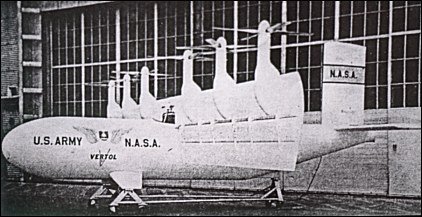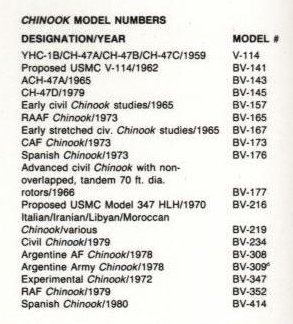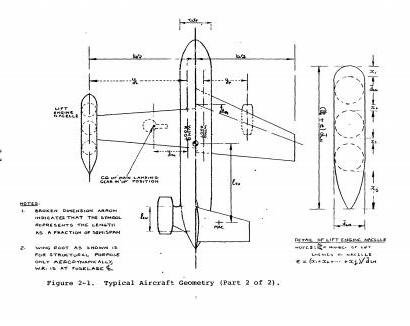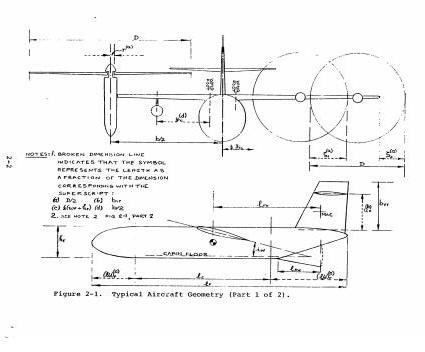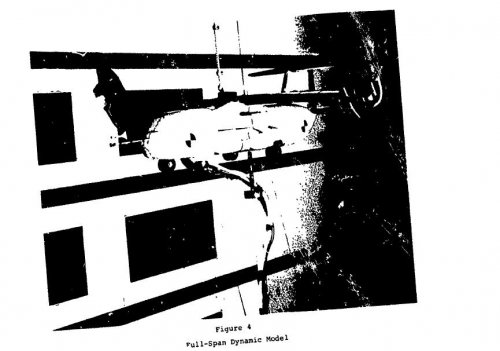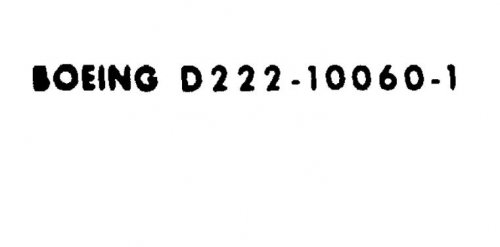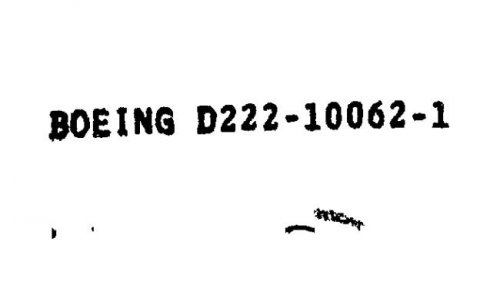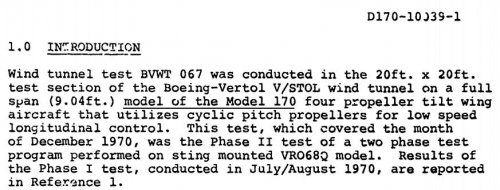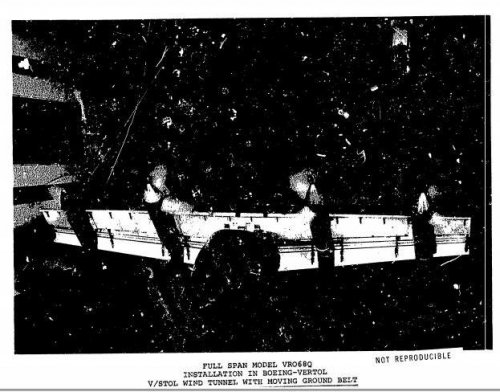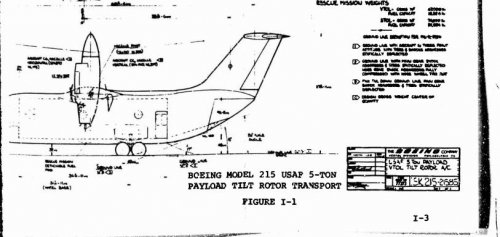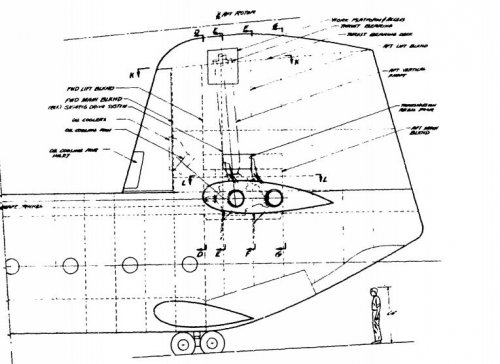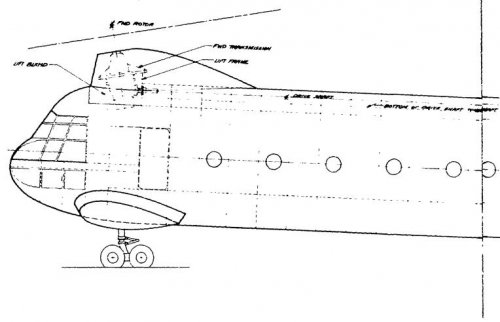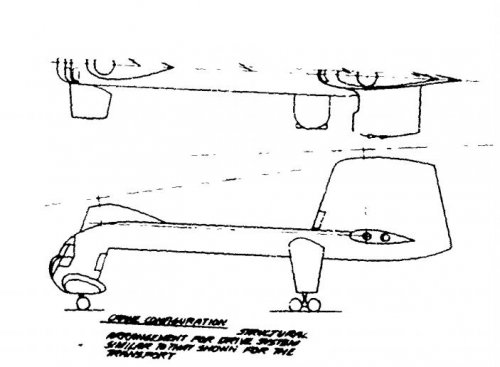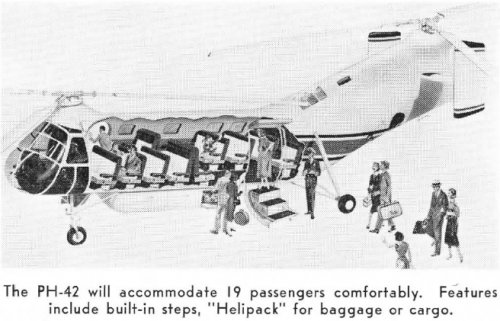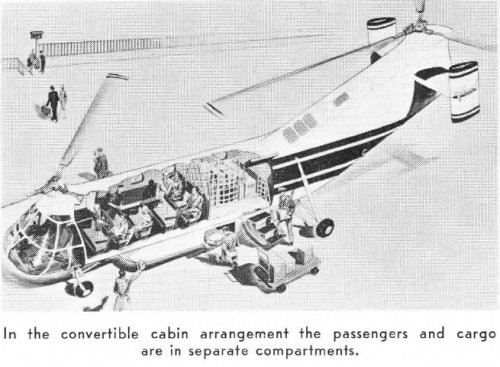You are using an out of date browser. It may not display this or other websites correctly.
You should upgrade or use an alternative browser.
You should upgrade or use an alternative browser.
Piasecki / Vertol / Boeing Helicopters model numbers
- Thread starter hesham
- Start date
- Joined
- 26 May 2006
- Messages
- 34,901
- Reaction score
- 15,761
Yes boxkite,
but the models 59,63,71,76 and 105 were to Vertol only.
Boeing-Vertol -222 :tilt-prop project using the fuselage,tail,and undercarriage
of Mitsubishi Mu-2J,engines in wing tip,project not built.
do you have information about Boeing model-858 helicopter?.
but the models 59,63,71,76 and 105 were to Vertol only.
Boeing-Vertol -222 :tilt-prop project using the fuselage,tail,and undercarriage
of Mitsubishi Mu-2J,engines in wing tip,project not built.
do you have information about Boeing model-858 helicopter?.
- Joined
- 26 May 2006
- Messages
- 34,901
- Reaction score
- 15,761
Thanks my dear Jemiba,
for dear boxkite,some Vertol helicopters:
V.63 HUP-4 :was HUP-2 (PV-18) fitted with an 800 hp R-1820 engine.
V.71 (H-21D) :two H-21C re-engined with G.E. T58 turboshafts engines.
V.76 :was VZ-2 to the Army (well known).
V.105 :was Model-44 fitted with two 825 hp Lycoming T-53 turboshafts,
prototype only.
for dear boxkite,some Vertol helicopters:
V.63 HUP-4 :was HUP-2 (PV-18) fitted with an 800 hp R-1820 engine.
V.71 (H-21D) :two H-21C re-engined with G.E. T58 turboshafts engines.
V.76 :was VZ-2 to the Army (well known).
V.105 :was Model-44 fitted with two 825 hp Lycoming T-53 turboshafts,
prototype only.
- Joined
- 8 January 2006
- Messages
- 1,612
- Reaction score
- 762
Jemiba said:..and some more:
- model 301 flying crane
- tilt wing for 90 passengers
- Rotafix, with two single bladed rotors
- and the model 222, mentioned by Hesham
From what I've read elsewhere and the picture here, the Model 222 appears to use the long version of the MU-2 fuselage and tail. That would certainly simplify trying to model such.
It actually makes a lot of sense because the wing on the MU-2 is a one-piece wing that can be replaced without disturbing a lot of the aircraft systems.
- Joined
- 25 June 2009
- Messages
- 14,753
- Reaction score
- 6,147
The two giants Bell and Sikorsky often make people forget about the third large company that made the helicopter a reality back in the late 1940s: P.V. Engineering Forum, later known as Piasecki Helicopters and then Piasecki Vertol. The company's assets were purchased by Boeing in the late 1950s, and though it now carried the name Boeing Vertol, the model numbering system carried on from where Piasecki had left off.
Frank Piasecki then set up a new business under his own name and came up with the Model 16-H PATHFINDER helicopter, which unfortunately failed to attract customers. Today his name and vision are being avenged as the name Piasecki is once again, half a century after takeover by Boeing, back in the military procurement business for a SPEEDHAWK conversion of a UH-60 designated X-49A.
Here is a list of model numbers. The former part of the list deals with Piasecki models. The latter part presents the Boeing Vertol models.
Pv.1 helicopter project
Pv.2 small helicopter
Pv.3 US Navy XHRP-X DOGSHIP , HRP-1 RESCUER rescue helicopter dubbed "Flying Banana"
Pv.11 utility helicopter developed from PV-2 for USN
Pv.12 large version of PV-14 for USN, project only
Pv.14 US Navy XHJP-1 utility helicopter
Pv.15 USAF YH-16 TRANSPORTER large transport helicopter (first prototype)
Pv.17 US Navy HRP-2 RESCUER
Pv.17? COMMUTER projected civilian version of HRP-2
Pv.17? CONNECTOR projected civilian version of HRP-2
Pv.17? DE LUXE projected civilian version of HRP-2
PD-/PV-18 US Navy HUP-1 RETRIEVER production version of Pv.14
PV-18 US Navy HUP-2 / HUP-3 / HUP-4 RETRIEVER / US Army H-25A ARMY MULE
PH-21 civilian same as Model 44A
PD-/PV-22 USAF YH-21 WORKHORSE tandem rotor helicopter
PA-39 GARGANTUA? concept of utilizing multiple helicopters joined together to lift a common payload
PH-/PV-42 USAF H-21A WORKHORSE military transport helicopter (AV 166)
PV-42 USAF H-21B WORKHORSE redesignated as CH-21B / Canada CH-125
PV-43 US Army H-21C SHAWNEE redesignated as CH-21C
(P)V-44A civilian transport helicopter, a civil version of PV-42 (AV 247,248)
(P)V-44B civilian float version
(P)V-44C civilian
PV-44 US Navy HKP-1 / Canada CH-127
PV-45 USAF YH-16A TRANSPORTER (initially designated H-27)
PH-55 RETRACTOPLANE , using rotor blades with reverse taper
59K US Army VZ-8P SKY CAR / AIRGEEP
59N US Navy 'PA-59' SEAGEEP
59H US Army VZ-8P( B ) AIRGEEP II "bent" in the middle so that the rotors were tilted fore and aft
(P)V-63 HUP-4 RETRIEVER, a HUP-2 (PV-18) fitted with an 800 hp R-1820 engine
(P)V-71 US Army XH-21D SHAWNEE
V.76 USAF VZ-2V experimental tilt-wing VTOL aircraft
PA-97 HELI-STAT large aircraft made up of a blimp and four H-21 fuselages; developed from PA-39 (PA-97-212/B)
105 Model 44 fitted with two 825 hp Lycoming T-53 turboshafts, prototype only
V.107 US Navy HRB-1 SEA KNIGHT redesignated as CH-46A
V.107 USAF XH-49A redesignated as XCH-46B, then canceled
V.107 Y/HC-1A redesignated as Y/CH-46C
V.107 SEA KNIGHT (US Navy CH-46D,-46E,-46F / HH-,UH-46D / VH-46F)
V.107 Canada CH-113 LABRADOR (107.II-9)
V.107? Canada CH-113A VOYAGEUR
V.107A no details
V.114 US Army YCH-1B CHINOOK redesignated as YCH-47A
V.114A US Army HC-1B CHINOOK redesignated as CH-47A (AV 259)
V.114A civilian variant (Type certificate H3EA)
V.114 US Army CH-47B CHINOOK
V.119 tilt-wing project (V.119F)
V.137 SC tri-service VTOL transport project, competing with XC-142A (SS-478A)
V.143 ACH-47A armed enemy suppression CHINOOK with externally mounted 20mm cannon, nose turret with grenade launcher and miniguns.
V.145 CH-47D CHINOOK version with T55-L-712 engines
BV.147 tilt-wing VTOL project
157 smaller inter-city helicopter project based on CHINOOK
160 tilt-rotor project
165 Australia CH-47C CHINOOK
166 VHL warm-cycle helicopter project (166-006)
167 larger inter-city helicopter project based on CHINOOK
BV.173 Canada CH-147 CHINOOK
176 Spain HT.17 export CH-47C
V.179? US Army YUH-61A UTTAS multirole helicopter
V.179 civilian projected civilian version of UH-61
V.189 no data
V.219 "CH-47C Plus" export version for Egypt, Greece, Iran, Italy, Morocco and Libya
222 tilt-rotor project using the fuselage, tail and undercarriage of a Mitsubishi MU-2J, engines in wing-tip pods
227 heavy crane project
BV.234 US Army CH-47C CHINOOK and civilian version
234ER civilian extended range version
234LR civilian long-range version
234MLR civilian long-range version
234UT civilian ultility version
234-68 projected stretched version of Model 234
235 US Army AAH contender, mock-up only
237 LAMPS III competitor of S-70L (or crane personnel carrier??)
297 US Army pre-H-62 heavy crane project
298 100-passenger flying crane project
299 flying crane project with payload 3-4 tons higher than Model 298
301 US Army XCH-62A HLH (Heavy Lift Helicopter) winner, later canceled
307 projected stretched version of Model 234 for 225 passengers
308 Argentine version of CH-47C CHINOOK for Argentine Air Force
309 Argentine version of CH-47C CHINOOK built in Italy, some for Argentine Army
309 Canada CH-147 CHINOOK no details as to difference with BV-173
347 CHINOOK version with wings
352 HC Mk.1 / HC Mk.1B / HC Mk.2 / HC Mk.2A / HC Mk.3 / etc. CHINOOK for UK (CH-47C)
360 Advanced Technology Demonstrator for the CHINOOK made of all-composite materials
414 CHINOOK international military version of CH-47D (BV-414-100)
NOTES:
- Later Piasecki designs are the PA-1, PA-2, 16-H PATHFINDER, 116H-1A and the recent AIRSCOUT
- Boeing Vertol later built the Bölkov Bö-105 under license as the EXECUTAIRE
- Two Boeing Models (71 and 90) are retractoplane design but don't seem to fit in this list
Frank Piasecki then set up a new business under his own name and came up with the Model 16-H PATHFINDER helicopter, which unfortunately failed to attract customers. Today his name and vision are being avenged as the name Piasecki is once again, half a century after takeover by Boeing, back in the military procurement business for a SPEEDHAWK conversion of a UH-60 designated X-49A.
Here is a list of model numbers. The former part of the list deals with Piasecki models. The latter part presents the Boeing Vertol models.
Pv.1 helicopter project
Pv.2 small helicopter
Pv.3 US Navy XHRP-X DOGSHIP , HRP-1 RESCUER rescue helicopter dubbed "Flying Banana"
Pv.11 utility helicopter developed from PV-2 for USN
Pv.12 large version of PV-14 for USN, project only
Pv.14 US Navy XHJP-1 utility helicopter
Pv.15 USAF YH-16 TRANSPORTER large transport helicopter (first prototype)
Pv.17 US Navy HRP-2 RESCUER
Pv.17? COMMUTER projected civilian version of HRP-2
Pv.17? CONNECTOR projected civilian version of HRP-2
Pv.17? DE LUXE projected civilian version of HRP-2
PD-/PV-18 US Navy HUP-1 RETRIEVER production version of Pv.14
PV-18 US Navy HUP-2 / HUP-3 / HUP-4 RETRIEVER / US Army H-25A ARMY MULE
PH-21 civilian same as Model 44A
PD-/PV-22 USAF YH-21 WORKHORSE tandem rotor helicopter
PA-39 GARGANTUA? concept of utilizing multiple helicopters joined together to lift a common payload
PH-/PV-42 USAF H-21A WORKHORSE military transport helicopter (AV 166)
PV-42 USAF H-21B WORKHORSE redesignated as CH-21B / Canada CH-125
PV-43 US Army H-21C SHAWNEE redesignated as CH-21C
(P)V-44A civilian transport helicopter, a civil version of PV-42 (AV 247,248)
(P)V-44B civilian float version
(P)V-44C civilian
PV-44 US Navy HKP-1 / Canada CH-127
PV-45 USAF YH-16A TRANSPORTER (initially designated H-27)
PH-55 RETRACTOPLANE , using rotor blades with reverse taper
59K US Army VZ-8P SKY CAR / AIRGEEP
59N US Navy 'PA-59' SEAGEEP
59H US Army VZ-8P( B ) AIRGEEP II "bent" in the middle so that the rotors were tilted fore and aft
(P)V-63 HUP-4 RETRIEVER, a HUP-2 (PV-18) fitted with an 800 hp R-1820 engine
(P)V-71 US Army XH-21D SHAWNEE
V.76 USAF VZ-2V experimental tilt-wing VTOL aircraft
PA-97 HELI-STAT large aircraft made up of a blimp and four H-21 fuselages; developed from PA-39 (PA-97-212/B)
105 Model 44 fitted with two 825 hp Lycoming T-53 turboshafts, prototype only
V.107 US Navy HRB-1 SEA KNIGHT redesignated as CH-46A
V.107 USAF XH-49A redesignated as XCH-46B, then canceled
V.107 Y/HC-1A redesignated as Y/CH-46C
V.107 SEA KNIGHT (US Navy CH-46D,-46E,-46F / HH-,UH-46D / VH-46F)
V.107 Canada CH-113 LABRADOR (107.II-9)
V.107? Canada CH-113A VOYAGEUR
V.107A no details
V.114 US Army YCH-1B CHINOOK redesignated as YCH-47A
V.114A US Army HC-1B CHINOOK redesignated as CH-47A (AV 259)
V.114A civilian variant (Type certificate H3EA)
V.114 US Army CH-47B CHINOOK
V.119 tilt-wing project (V.119F)
V.137 SC tri-service VTOL transport project, competing with XC-142A (SS-478A)
V.143 ACH-47A armed enemy suppression CHINOOK with externally mounted 20mm cannon, nose turret with grenade launcher and miniguns.
V.145 CH-47D CHINOOK version with T55-L-712 engines
BV.147 tilt-wing VTOL project
157 smaller inter-city helicopter project based on CHINOOK
160 tilt-rotor project
165 Australia CH-47C CHINOOK
166 VHL warm-cycle helicopter project (166-006)
167 larger inter-city helicopter project based on CHINOOK
BV.173 Canada CH-147 CHINOOK
176 Spain HT.17 export CH-47C
V.179? US Army YUH-61A UTTAS multirole helicopter
V.179 civilian projected civilian version of UH-61
V.189 no data
V.219 "CH-47C Plus" export version for Egypt, Greece, Iran, Italy, Morocco and Libya
222 tilt-rotor project using the fuselage, tail and undercarriage of a Mitsubishi MU-2J, engines in wing-tip pods
227 heavy crane project
BV.234 US Army CH-47C CHINOOK and civilian version
234ER civilian extended range version
234LR civilian long-range version
234MLR civilian long-range version
234UT civilian ultility version
234-68 projected stretched version of Model 234
235 US Army AAH contender, mock-up only
237 LAMPS III competitor of S-70L (or crane personnel carrier??)
297 US Army pre-H-62 heavy crane project
298 100-passenger flying crane project
299 flying crane project with payload 3-4 tons higher than Model 298
301 US Army XCH-62A HLH (Heavy Lift Helicopter) winner, later canceled
307 projected stretched version of Model 234 for 225 passengers
308 Argentine version of CH-47C CHINOOK for Argentine Air Force
309 Argentine version of CH-47C CHINOOK built in Italy, some for Argentine Army
309 Canada CH-147 CHINOOK no details as to difference with BV-173
347 CHINOOK version with wings
352 HC Mk.1 / HC Mk.1B / HC Mk.2 / HC Mk.2A / HC Mk.3 / etc. CHINOOK for UK (CH-47C)
360 Advanced Technology Demonstrator for the CHINOOK made of all-composite materials
414 CHINOOK international military version of CH-47D (BV-414-100)
NOTES:
- Later Piasecki designs are the PA-1, PA-2, 16-H PATHFINDER, 116H-1A and the recent AIRSCOUT
- Boeing Vertol later built the Bölkov Bö-105 under license as the EXECUTAIRE
- Two Boeing Models (71 and 90) are retractoplane design but don't seem to fit in this list
- Joined
- 26 May 2006
- Messages
- 34,901
- Reaction score
- 15,761
Hi,
for Vertol PV.63 and V.105,I spoke about them and my dears Boxkite and
Jemiba spoke about PV.119 here;
and about PV.11 and PV.12 please see;
for Vertol PV.63 and V.105,I spoke about them and my dears Boxkite and
Jemiba spoke about PV.119 here;
and about PV.11 and PV.12 please see;
- Joined
- 25 June 2009
- Messages
- 14,753
- Reaction score
- 6,147
A Wichita State University listing found on the web mentions a Vertol Model 90, stating that a 15% wind tunnel model was tested.
http://specialcollections.wichita.edu/collections/university_archives/record_groups/finding_aids/pdf/06-12-00-05.pdf
Another Vertol program I can find no designation for is this early tilt-wing six-prop sub-scale demonstrator. It carries the U.S. Army and N.A.S.A. logos, but I have never been able to properly identify it. I enclose a photo hoping someone may come up with some clues...
http://specialcollections.wichita.edu/collections/university_archives/record_groups/finding_aids/pdf/06-12-00-05.pdf
Another Vertol program I can find no designation for is this early tilt-wing six-prop sub-scale demonstrator. It carries the U.S. Army and N.A.S.A. logos, but I have never been able to properly identify it. I enclose a photo hoping someone may come up with some clues...
Attachments
The 222 was a tilt-rotor, not a tilt-prop. It was proposed in the NASA competition that resulted in the XV-15.
saturncanuck
Any landing you can walk away from, is a good one.
Stargazer2006 said:A University of Wichita listing found on the web mentions a Vertol Model 90, stating that a 15% wind tunnel model was tested.
http://specialcollections.wichita.edu/collections/university_archives/record_groups/finding_aids/pdf/06-12-00-05.pdf
Another Vertol program I can find no designation for is this early tilt-wing six-prop sub-scale demonstrator. It carries the U.S. Army and N.A.S.A. logos, but I have never been able to properly identify it. I enclose a photo hoping someone may come up with some clues...
OMG what the **** is that???!!!
- Joined
- 8 January 2006
- Messages
- 1,612
- Reaction score
- 762
Stargazer2006 said:A University of Wichita listing found on the web mentions a Vertol Model 90, stating that a 15% wind tunnel model was tested.
http://specialcollections.wichita.edu/collections/university_archives/record_groups/finding_aids/pdf/06-12-00-05.pdf
Another Vertol program I can find no designation for is this early tilt-wing six-prop sub-scale demonstrator. It carries the U.S. Army and N.A.S.A. logos, but I have never been able to properly identify it. I enclose a photo hoping someone may come up with some clues...
One small correction, it's Wichita State University, not University of Wichita. *chuckle* I should know as I did graduate work there (but for getting laid off by Learjet in the summer of 1982 and moving to California, I probably would've gotten my MSAE there).
- Joined
- 25 June 2009
- Messages
- 14,753
- Reaction score
- 6,147
From the Spangenberg Index, courtesy of RyanCrierie:
PIASECKI:
- PD-22B HP class ASW helicopter proposal
- PD-22E assault helicopter proposal
- PD-22F HS class ASW helicopter proposal
- PH-26 and -26A HP class ASW CONVERTAPLANE helicopter proposal
- PH-32 HS class ASW helicopter proposal
- PH-34, -34A and -34B assault transport helicopter proposal
- PH-47 HS class ASW helicopter proposal
- PH-49 observation and liaison helicopter (HO class) project
- PH-51 observation and liaison helicopter (HO class) project
PIASECKI:
- PD-22B HP class ASW helicopter proposal
- PD-22E assault helicopter proposal
- PD-22F HS class ASW helicopter proposal
- PH-26 and -26A HP class ASW CONVERTAPLANE helicopter proposal
- PH-32 HS class ASW helicopter proposal
- PH-34, -34A and -34B assault transport helicopter proposal
- PH-47 HS class ASW helicopter proposal
- PH-49 observation and liaison helicopter (HO class) project
- PH-51 observation and liaison helicopter (HO class) project
- Joined
- 26 May 2006
- Messages
- 34,901
- Reaction score
- 15,761
From the Spangenberg Index, courtesy of RyanCrierie;
Vertol V.82 was the contender for Kaman K-19 and K-20 to
USN 1956 Specification for a fast amphibious utility helicopter
which the winner was Kaman K-20 Seasprite.
Vertol V.82 was the contender for Kaman K-19 and K-20 to
USN 1956 Specification for a fast amphibious utility helicopter
which the winner was Kaman K-20 Seasprite.
- Joined
- 26 May 2006
- Messages
- 34,901
- Reaction score
- 15,761
Very strange,
in the DTIC report which was discovered by the member
Triton;
http://www.dtic.mil/cgi-bin/GetTRDoc?AD=ADA085290&Location=U2&doc=GetTRDoc.pdf
about the Boeing Vertol HLH helicopter,they wrote
that;the report number D301-10323-1,and in that report
you will find the Model-301 as the meaning of D301,but
in the two NASA reports which I discovered them about
the same company we will find that;
1-Report No or number D210-10873-1
2-Report No or number D238-10000-3
And we refused to call them Model-210 and Model-238,
why,give me a good reason for all and not only for the last
two reports.
http://ntrs.nasa.gov/archive/nasa/casi.ntrs.nasa.gov/19750022072_1975022072.pdf
http://ntrs.nasa.gov/archive/nasa/casi.ntrs.nasa.gov/19770010060_1977010060.pdf
in the DTIC report which was discovered by the member
Triton;
http://www.dtic.mil/cgi-bin/GetTRDoc?AD=ADA085290&Location=U2&doc=GetTRDoc.pdf
about the Boeing Vertol HLH helicopter,they wrote
that;the report number D301-10323-1,and in that report
you will find the Model-301 as the meaning of D301,but
in the two NASA reports which I discovered them about
the same company we will find that;
1-Report No or number D210-10873-1
2-Report No or number D238-10000-3
And we refused to call them Model-210 and Model-238,
why,give me a good reason for all and not only for the last
two reports.
http://ntrs.nasa.gov/archive/nasa/casi.ntrs.nasa.gov/19750022072_1975022072.pdf
http://ntrs.nasa.gov/archive/nasa/casi.ntrs.nasa.gov/19770010060_1977010060.pdf
Attachments
- Joined
- 25 June 2009
- Messages
- 14,753
- Reaction score
- 6,147
hesham said:And we refused to called them Model-210 and Model-238,
why,give me a good reason for all and not only for the last
two reports.
First of all, I don't think anybody here REFUSED to call any design anything... I have no problems with D210 and D238 meaning D-210 and D-238 if the rest of the clues are consistent (dates, etc.). All that I and other members said was that we must be cautious with drawing hasty conclusions as you often do. I myself resort to the same kind of deductions as you do but I don't assert them as fact, and most of the time I only write about them when they are confirmed.
Secondly, your use of the word "Model" is definitely wrong. The "D-" series applies to designs, not models. The model numbers constitute a separate numeral list from the D- numbers.
- Joined
- 26 May 2006
- Messages
- 34,901
- Reaction score
- 15,761
- Joined
- 25 June 2009
- Messages
- 14,753
- Reaction score
- 6,147
Interesting find, hesham, but I'd be cautious before drawing that conclusion about this design. Indeed, the brochure is about a program called VASCOMP II (V/STOL Aircraft Sizing and Performance Computer Program II), and the image is simply what the caption says: "Typical Aircraft Geometry", serving as a generic reference for what V/STOL aircraft should look like. The manual contains only this aircraft illustration, the rest is full of technical computing diagrams. Now maybe Model 170 was allocated to that generic study model, maybe not. I don't think we have enough elements here to decide that the image is it, though.
- Joined
- 26 May 2006
- Messages
- 34,901
- Reaction score
- 15,761
hesham said:Very strange,
in the DTIC report which was discovered by the member
Triton;
http://www.dtic.mil/cgi-bin/GetTRDoc?AD=ADA085290&Location=U2&doc=GetTRDoc.pdf
about the Boeing Vertol HLH helicopter,they wrote
that;the report number D301-10323-1,and in that report
you will find the Model-301 as the meaning of D301,but
in the two NASA reports which I discovered them about
the same company we will find that;
1-Report No or number D210-10873-1
2-Report No or number D238-10000-3
And we refused to call them Model-210 and Model-238,
why,give me a good reason for all and not only for the last
two reports.
http://ntrs.nasa.gov/archive/nasa/casi.ntrs.nasa.gov/19750022072_1975022072.pdf
http://ntrs.nasa.gov/archive/nasa/casi.ntrs.nasa.gov/19770010060_1977010060.pdf
That again,I think I was right;
in DTIC document,we find this reference;
4- Investigation of the Performance of Low Disc Loading Tilt Rotors in Hovering and
Cruise Flights. (NASA Contract NAS2-5025) Boeing-Vertol Division Report
D160-10013-1, March 1971.
and we find again the report D160-10013-1 means Model-160 as we know it here;
http://www.secretprojects.co.uk/forum/index.php/topic,7005.msg128188.html#msg128188
so I think that;
D210 means Model-210
D238 means Model-238
and we consider also;
D180 means Model-180
the source for my evidence ;
http://www.dtic.mil/dtic/tr/fulltext/u2/757267.pdf
Attachments
- Joined
- 25 June 2009
- Messages
- 14,753
- Reaction score
- 6,147
I think we need more evidence before we can jump to such conclusions. Please be careful, you have made mistakes in the past (and so have I) trying to find logic in report numbers, so let's not turn hypotheses into false certainties.
- Joined
- 26 May 2006
- Messages
- 34,901
- Reaction score
- 15,761
Stargazer2006 said:I think we need more evidence before we can jump to such conclusions. Please be careful, you have made mistakes in the past (and so have I) trying to find logic in report numbers, so let's not turn hypotheses into false certainties.
No,
I didn't mean this,but my theory is; the first number allocates for Designation
and the second number allocates to report number.
- Joined
- 26 May 2006
- Messages
- 34,901
- Reaction score
- 15,761
Hi,
the third evidence,in two NASA reports,there is the same conclusion,
D222-10062-1 was also called Boeing-Vertol Model-222,and the second number
was for report.
Also in the second report,D222-10060-1,was also Boeing Vertol Model-222
and the second number was for the report,but there is many reports,so
one called 10062-1 and the second called 10060-1.
And D222 meant Model-222.
http://ntrs.nasa.gov/archive/nasa/casi.ntrs.nasa.gov/19730023205_1973023205.pdf
http://ntrs.nasa.gov/archive/nasa/casi.ntrs.nasa.gov/19730021277_1973021277.pdf
the third evidence,in two NASA reports,there is the same conclusion,
D222-10062-1 was also called Boeing-Vertol Model-222,and the second number
was for report.
Also in the second report,D222-10060-1,was also Boeing Vertol Model-222
and the second number was for the report,but there is many reports,so
one called 10062-1 and the second called 10060-1.
And D222 meant Model-222.
http://ntrs.nasa.gov/archive/nasa/casi.ntrs.nasa.gov/19730023205_1973023205.pdf
http://ntrs.nasa.gov/archive/nasa/casi.ntrs.nasa.gov/19730021277_1973021277.pdf
Attachments
- Joined
- 25 June 2009
- Messages
- 14,753
- Reaction score
- 6,147
From the Bernard Lindenbaum Vertical Flight Research Collection:
PH-29...........no details; blueprint exists
129...............Ground Effect Take-off and Landing (GETOL) Flight Research Vehicle (FRV) (1962)
137/SC.........tri-service VTOL tilt-wing transport project, competing with XC-142A (SS-478A) (1961)
150...............tilt-wing/tilt-rotor airplane studies (1966)
160...............V/STOL tilt-rotor aircraft project (1968)
180...............possible designation of Lift/Cruise Fan Technology V/STOL Research Airplane (a modified T-39)
189...............Sea Control Fighter System Development Proposal (1972)
210...............probable designation of various V/STOL studies
213...............V/STOL Tilt/Stowed-Rotor aircraft project
215...............tilt-rotor VTOL project
340...............possible designation of Quiet Short Haul Research Aircraft / USB Propulsive-Lift Aircraft
nd.................HELIJET Lateral Twin Folding Rotor V/STOL Aircraft evaluated by ONR/Army (1968)
nd.................ROTAFIX, no details (1968)
nd.................VERTODYNE, dual propulsion system evaluated by ONR for the Army
NOTES:
- Some of these designations carry the prefix BV- while in others it was omitted.
- The hypothetical ones are derived from the report numbers which are preceded by the letter D (e.g. D180, D210).
- Not all D* report numbers concern aircraft or helicopters, which leads one to think that probably NOT all BV- numbers exist, only those where a study becomes a true project.
PH-29...........no details; blueprint exists
129...............Ground Effect Take-off and Landing (GETOL) Flight Research Vehicle (FRV) (1962)
137/SC.........tri-service VTOL tilt-wing transport project, competing with XC-142A (SS-478A) (1961)
150...............tilt-wing/tilt-rotor airplane studies (1966)
160...............V/STOL tilt-rotor aircraft project (1968)
180...............possible designation of Lift/Cruise Fan Technology V/STOL Research Airplane (a modified T-39)
189...............Sea Control Fighter System Development Proposal (1972)
210...............probable designation of various V/STOL studies
213...............V/STOL Tilt/Stowed-Rotor aircraft project
215...............tilt-rotor VTOL project
340...............possible designation of Quiet Short Haul Research Aircraft / USB Propulsive-Lift Aircraft
nd.................HELIJET Lateral Twin Folding Rotor V/STOL Aircraft evaluated by ONR/Army (1968)
nd.................ROTAFIX, no details (1968)
nd.................VERTODYNE, dual propulsion system evaluated by ONR for the Army
NOTES:
- Some of these designations carry the prefix BV- while in others it was omitted.
- The hypothetical ones are derived from the report numbers which are preceded by the letter D (e.g. D180, D210).
- Not all D* report numbers concern aircraft or helicopters, which leads one to think that probably NOT all BV- numbers exist, only those where a study becomes a true project.
- Joined
- 26 May 2006
- Messages
- 34,901
- Reaction score
- 15,761
Also;
238 was tilt-rotor aircraft project.
http://www.secretprojects.co.uk/forum/index.php/topic,5301.15.html
238 was tilt-rotor aircraft project.
http://www.secretprojects.co.uk/forum/index.php/topic,5301.15.html
- Joined
- 26 May 2006
- Messages
- 34,901
- Reaction score
- 15,761
PV-45 was XH-27 designation as in;
http://www.samolotypolskie.pl/samoloty/2093/84/Piasecki-PV-15-PV-45-H-16-Transporter
http://www.samolotypolskie.pl/samoloty/2093/84/Piasecki-PV-15-PV-45-H-16-Transporter
- Joined
- 26 May 2006
- Messages
- 34,901
- Reaction score
- 15,761
hesham said:Hi,
a reference to Boeing Vertol Model 170-544P V/STOL aircraft
is here;
http://www.dtic.mil/cgi-bin/GetTRDoc?AD=ADA088833&Location=U2&doc=GetTRDoc.pdf
with two unidentified drawings.
Anther evidence for D and a number after it,was the design number;
a reference D170-10039-1 means Model-170 as in the same source;
http://www.dtic.mil/dtic/tr/fulltext/u2/734236.pdf
The Model-170 was a tilt-wing V/STOL aircraft.
Attachments
- Joined
- 26 May 2006
- Messages
- 34,901
- Reaction score
- 15,761
I found this report from DTIC,spoke about Boeing Vertol SK142,
and may be (only my suggesting),it was Model 142;
http://www.dtic.mil/dtic/tr/fulltext/u2/622586.pdf
And as you see in Boeing Verol Model 215 report,they wrote on
the drawing SK215 also;
http://www.dtic.mil/dtic/tr/fulltext/u2/881749.pdf
and may be (only my suggesting),it was Model 142;
http://www.dtic.mil/dtic/tr/fulltext/u2/622586.pdf
And as you see in Boeing Verol Model 215 report,they wrote on
the drawing SK215 also;
http://www.dtic.mil/dtic/tr/fulltext/u2/881749.pdf
Attachments
- Joined
- 26 May 2006
- Messages
- 34,901
- Reaction score
- 15,761
Stargazer2006 said:From the Bernard Lindenbaum Vertical Flight Research Collection:
150...............tilt-wing/tilt-rotor airplane studies (1966)
NOTES:
- Some of these designations carry the prefix BV- while in others it was omitted.
- The hypothetical ones are derived from the report numbers which are preceded by the letter D (e.g. D180, D210).
- Not all D* report numbers concern aircraft or helicopters, which leads one to think that probably NOT all BV- numbers exist, only those where a study becomes a true project.
You are right;
http://ntrs.nasa.gov/archive/nasa/casi.ntrs.nasa.gov/19720018375_1972018375.pdf
Attachments
- Joined
- 12 July 2006
- Messages
- 948
- Reaction score
- 749
Skyblazer said:...
Here is a list of model numbers. The former part of the list deals with Piasecki models...
...
PH-/PV-42 USAF H-21A WORKHORSE military transport helicopter (AV 166)
Checking old issues of the American Helicopter Magazine (thanks to @vstol
Attachments
- Joined
- 26 May 2006
- Messages
- 34,901
- Reaction score
- 15,761
We mixed here between two separated companies,
- Piasecki Helicopter Corporation; which was formed in 1945/46,and its products were taken the series PV or
PD at first,then changed into PH,from PV-1 up to PH-74,later switched to be Vertol in March 1956,PV 1,2,3,8,9,
11,12,14,15,16,17,18,19,21.22.PH 26,29.32,34,42,43,44,45,47,49,51.54,55,63,71 & 74..
- Piasecki Aircraft Corporation; which was founded in 1955/56,and its products were taken the series PA,that
included, PA 1,2,4,16,22,39,59,61,67,97,101,107,116,159,216,316 & 890
- Piasecki Helicopter Corporation; which was formed in 1945/46,and its products were taken the series PV or
PD at first,then changed into PH,from PV-1 up to PH-74,later switched to be Vertol in March 1956,PV 1,2,3,8,9,
11,12,14,15,16,17,18,19,21.22.PH 26,29.32,34,42,43,44,45,47,49,51.54,55,63,71 & 74..
- Piasecki Aircraft Corporation; which was founded in 1955/56,and its products were taken the series PA,that
included, PA 1,2,4,16,22,39,59,61,67,97,101,107,116,159,216,316 & 890
Last edited:
- Joined
- 26 May 2006
- Messages
- 34,901
- Reaction score
- 15,761
We mixed here between two separated companies,
- Piasecki Helicopter Corporation; which was formed in 1945/46,and its products were taken the series PV or
PD at first,then changed into PH,from PV-1 up to PH-74,later switched to be Vertol in March 1956.
- Piasecki Aircraft Corporation; which was founded in 1955/56,and its products were taken the series PA,that
included, PA 1,2,4,16,22,39,59,61,67,97,101,107,159,316 & 890
Later I will speak about both companies in details.
Kiltonge
Greetings Earthling
- Joined
- 24 January 2013
- Messages
- 635
- Reaction score
- 1,195
Per Flight, 21 March 1958 a little more about the 105. The turbine engine installation was intended to be offered to operators as a bolt-in kit replacing the piston engine. The T53 and T58 engines were both offered under the same model number.
- Joined
- 26 May 2006
- Messages
- 34,901
- Reaction score
- 15,761
We mixed here between two separated companies,
- Piasecki Helicopter Corporation; which was formed in 1945/46,and its products were taken the series PV or
PD at first,then changed into PH,from PV-1 up to PH-74,later switched to be Vertol in March 1956,PV 1,2,3,8,9,
11,12,14,15,16,17,18,19,21.22.PH 26,29.32,34,42,43,44,45,47,49,51.54,55,63,71 & 74..
- Piasecki Aircraft Corporation; which was founded in 1955/56,and its products were taken the series PA,that
included, PA 1,2,3,4,5,6,7,8,9,10,11,12,14,16,21,22,39,59,61,67,97,101,107,116,159,216,316 & 890
As I promised;
Piasecki Aircraft Corporation of 1955/56;
PA.1 was a heavy lift and transport helicopter project of 1955,with a turbojet drive located at the end of the
five rotor blades.
PA.2B was purchased the second prototype of the Platt-LePage XR-1A helicopter, built with a transverse
arrangement of the main rotors. He planned to develop the Piasecki PA-2B convertible wing on its basis.
PA.2C was a VTOL Experimental aircraft capable of sustained, high-speed level flight (operating from aircraft carriers, cruisers, destroyers, and unprepared landing sites). Called the “RingWing”, it combined two ducted propellers that contained an integrated system of vanes to deflect the slip stream downwards
PA.3 ? may it was the study of a multi-rotor helicopter for transporting a 50-ton tank,based on PA.1 probably,
the high cost of work on improving the project caused the work to be discontinued
PA.4 Sea-Bat was an early quad-rotor unmanned air vehicle developed for shipboard use and weapons delivery,
the drone's control system and rotor were configured to allow the aircraft's center body to keep a constant
azimuth heading regardless of the UAV's direction of travel. Two pairs of tilting 12 foot propellers with dual
differential collective control allowed the aircraft to be omni-directional. A vertical gyroscope sent signals to
the differential pitch of each pair of rotors to maintain a constant heading. The two pairs of rotors each turned
in an opposite direction, but were balanced in torque in all positions by differential tilt angle
PA.5 ? may it was heavy flying crane helicopter project,in USAF competition,1956
PA.6 ? SKY-SPY may was a RPV project,or unmanned surveillance aircraft project,it was developed on PA-2,1956/57
PA.7 ? Mud-Bat may was a redesigned of PA.4,in different size to meet specific mission requirement,1958
PA.8 ? Ice-Bat may also another concept from PA.4 to use in Ice area,in different size to meet specific mission
requirement,1958
PA.9 ? may it was a patent for two PV- 3 helicopters,joined together with assist of one Balloon,mounted between
the pare on the middle,for heavy lift,1958/59
PA.10 ? may it was a single seat VTOL attack aircraft project,an improved version of PA.2,1959/60
PA.11 ? may a high tilt-wing VTOL small aircraft project,powered by two turboprop engines,mounted in
nacelles from the wings,1959/60
PA.12 ? may it was a four tilt ducted fan medium transport VTOL aircraft project,1959/60
PA.13 maybe not used
PA.14 ? may it was a VTOL convertiplane project,had a main rotor with two engines mounted in the wings,also'
had a gull-wing,could accommodated more than 20 passenger,1960
PA.15? may a VTOL experimental convertiplane project,vertical take-off and landing [VTOL] aircraft having its
flight directional horizontal axis when grounded the lift during taking-off being created by free or ducted
propellers or by blowers the propellers being fixed relative to the fuselage,small airplane with tandem two-
seat
PA.16 Pathfinder 16H-1 was a two-seat compound helicopte,powered by one 405 shp PWC PT6B-2 turboshaft
engine,1960
PA.16 Pathfinder II 16H-1A was a larger version with one 1,250 shp T58-GE-8 turboshaft engine
PA.16 Pathfinder II 16H-1B was the same as 16H-1A,but with tail duct stabilizing moment
PA.16 Pathfinder II 16H-1C was proposed conversion of the 16H-1A with one 1,500 shp T58-GE-5 turboshaft
engine
PA.16 Pathfinder II 16H-1H was a larger version of 16H-1A,powered by one engine
PA.16 Pathfinder II 16H-1HT reported development of a high-performance version with 4 passengers, intended to be powered by a 986shp Turbomeca Astazou XVI engine
PA.16 Pathfinder II 16H-2 was unknown variant
PA.16 Pathfinder III 16H-3F proposed twin-turbine design using the 16H-1A fuselage with two T58-GE-10 engines and 4-blade rotor and tail fan, for SAR, ASW, and military utility applications.
PA.16 Pathfinder III 16H-3H Heli-Plane was a project for an 8-passenger executive transport with twin PT6 or TPE 331 turboshaft engines
PA.16 Pathfinder III 16H-3J was a 15-seat compound helicopter project,powered by two turboshaft engines
PA.16 Pathfinder III 16H-3K was developed from 16H-3J,powered by two 750 shp PT6B-30 turboshaft engines
PA.16 Pathfinder III 16H-4 was a Westland Model 30-300,fitted with tail ducted fan
PA.17 to PA.20 ------?
PA.21 ? may a single seat small ring-wing tilt ducted fan VTOL fighter project,1961
PA.22 was a single seat supersonic ring-wing tilt ducted fan VTOL fighter project,developed from previous
entry,1961/62
PA.23 to PA.36 ------?
PA.37 ? may it was a four helicopters,joined together for heavy lift,project led to Gargantua
PA.38 ? may it was a two helicopters,joined together for heavy lift,project led to Gargantua
PA.39 Gargantua it was a concept of utilizing multiple helicopters joined together to lift a common payload,1970
PA.40 to PA.58 ------?
PA.59K Skycar was a two-seat VTOL flying Jeep,powered by two 180 hp Lycoming O-360-A2A piston engines,
given the military designation VZ-8P Airgeep. Later, the piston engines were replaced by a single 425 hp
Turbomeca Artouste IIB turboshaft engine,1956/57
PA.59N Seageep I after the piston engines were replaced by a single Artouste, whilst on loan to the United States
Navy, fitted with floats
PA.59H Airgeep II was the second aircraft, military designation VZ-8P (B), completed with two 400 hp Turbomeca
Artouste IIC turboshaft engines and seats for up to five, including the crew
PA.60 ------?
PA.61A was a fast amphibious utility helicopter project,intended to compete Kaman K-19 & K-20
PA.62 to PA.66 ------?
PA.67 was an observation airplane project of 1956,intended to submit for Spec. TS-145
PA.68 to PA.83 ------?
PA.84-X-5 was a vectored thrust take-off and landing recoverable strike RPV Project of 1973
PA.85 to PA.96 ------?
PA.97 Heli-State it was an experimental heavy-lift aircraft,four helicopter joined together with large dirigible,1975
PA.97-0001-C Heli-State was a matrix of 12 helicopters,joined together,project of 1975
PA.97-0004 Heli-State was a 75 ton version,using four existing CH-53D helicopters,1975
PA.97-0011 Heli-State was a 140 ton version,using four existing CH-53E helicopters,1975
PA.97-034J Heli-State was a naval version,using a four existing Sikorsky H-34J helicopters1979-1986
PA.97-212B Heli-State was a version project,using existing four Bell 212B helicopters,1977
PA.98 to PA.100 ------?
PA.101D was agreement of a licence built Agusta A.101D,in 1958/60
PR.107 was a high performance observation and reconnaissance aircraft project,I suspect in this designation,
1955/56
PA.116 was a development of PA.16 (16H),project,no more details
PA.159B was an improvement version of PA.59,with new VTOL propulsion system,project
PA.159-X-36 was a preliminary studt for STAMP (Small Tactical Aerial Mobility Platform)
PA.216 was also a development of PA.16 (16H),project,no more details
PA.243-X-2 was a Proposal for Investigation of the Techniques for and the Problems of Designing
Variable Diameter Rotors Having Large Ratios of Extended to Retract Span
PA.243-X-3 was a Cost Proposal for Investigation of the Techniques for and the Problems of Designing
Variable Diameter Rotors Having Large Ratios of Extended to Retract Span
PA.255-X-3 was a proposal for Air to Air Launch and Retrieval System,1972
PA.316-X-7 was a Kaman SH-2D helicopter,with Ring-Tail for safety and high speed
PA.890 was EVTOL Slowed Rotor Winged Compound Helicopter Project
- To be continued
Last edited:
Similar threads
-
Boeing Vertol BV-160 tilt-rotor aircraft
- Started by hesham
- Replies: 14
-
Boeing Vertol BV-307 commercial helicopter project
- Started by boxkite
- Replies: 14
-
-
Boeing Vertol alternate HLH proposals and other crane helicopters
- Started by boxkite
- Replies: 153
-

